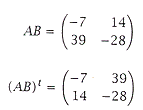| (a) | Let A be the null set. | |
| (i) What is the cardinality of A? | [1] | |
| (ii) What is the cardinality of the power set P(A)? | [1] | |
| (iii) What is the cardinality of the power set P(P(A))? | [1] | |
| (iv) List the elements of the power set P(P(P(A))). | [1] | |
| (i) Cardinality of A =
0 (ii) The power of set P(A) = {Æ} Cardinality of power set P(A) = 1 (iii) P(P(A)) = {Æ, {Æ}} Cardinality of power set P(P(A)) = 2 (iv) Elements of the power set P(P(P(A))) = {Æ, {Æ}, {{Æ}}, {Æ, {Æ}}}
|
||
| (b) | Consider the following statement " basketball players x, x is tallWhich of the following are equivalent ways of expressing this statement? |
[2] |
| (i) Every basketball player is tall. | ||
| (ii) Some basketball players are tall. | ||
| (iii) Some of all tall people are basketball players. | ||
| (iv) Anyone who is tall is a basketball player. | ||
| (v) All people who are basketball players are tall | ||
| Every basketball
player is tall. All people who are basketball players are tall.
|
||
| (c) | (i) How many ways can the letters of the word DESIGN be arranged in a row? | [1] |
| (ii) How many ways can the letters of the word DESIGN be arranged in a row if G and N must remain next to each other as either GN or NG? | [2] | |
| (i) No. of ways = 6! = 6 * 5 *4 * 3 * 2 * 1 = 720 (ii) If GN is
next to each other, No. of ways = 5!
|
||
| (d) | Given the matrices |
[3] |
 |
||
| (e) | Calculate the inverse of the function f(x) = 10 - 2x |
[3] |
| f(x) = 10 - 2x Let y = 10 - 2x y - 10 = -2x 2x = 10 - y x = (10 - y) / 2 f-1(x) = (10 - x) / 2
|
||
| (f) | Prove by induction that n3 - n is divisible by 6 for n ³ 1. | [5] |
| Let n = 1, n3
- n = 13 - 1 = 0 is divisible by 6. It is true for P(1). Assume
that it is true for P(k) Proof: (k + 1)3 - (k +
1) \ We have proven that n3 - n is divisible by 6 for n ³ 1 by mathematics induction. |
 ,
,